Days 368-378: Syria
Despite its runner-up status in the administration’s “Axis of Evil”, we decided to visit Syria. Every traveller who’s been to the place has had nothing but good things to say about the Syrians. So with that and Marcus’ “good luck” string from a Buddhist monk nine months ago still attached, we figured we had nothing to worry about.
Our ride from the border to Aleppo took us through a landscape that was not all that different from Turkey; rolling hills covered in olive trees and marble quarries. When we enter a new country that we’re not familiar with the local customs, we try to catch what the locals are wearing (Marcus hasn’t been able to wear shorts for like a year!). Since Syria was our first “real” middle eastern country, we were paying particular attention to headwear for women and were pleased to see that a significant fraction of women not wearing the hijab. That’s a good thing since we still haven’t figure out how to tie one properly.
Our very first stop in the Middle East was this felafel place. The speed and volume of felafel produced made our fast-food joints in the states look slow. The felafel sandwiches were terrific!
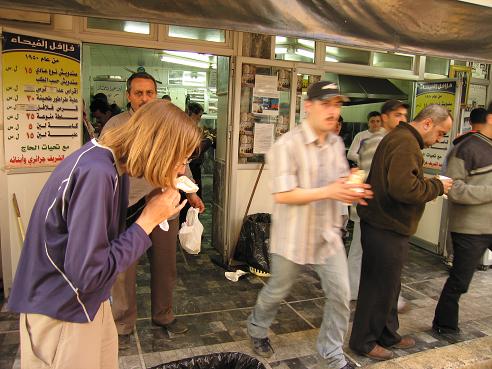
We only had enough money for felafel and needed some cash. The ATMs we tried rejected our card (but thankfully didn’t eat it). We needed to find an internet cafe to look up where the banks are in Aleppo, but the places listed in our guidebook were gone. We got pointed in the right direction by some locals but still couldn’t find one. Eventually, we ended up at a corner that felt like it had that “internet cafe vibe” (you learn to pick up on these things) and Marcus declared, “I’m not leaving this spot until we find an internet cafe.” We looked around for a few minutes and then noticed a guy in the restaurant behind us making the typing motion at us. We nodded and he pointed above our heads where a large sign indicated an internet place upstairs. It was awesome.
Our first day in Syria was a very pleasant introduction to the genuine friendliness and welcoming attitude of the Syrians. Everywhere we went people (just regular folks, not touts) would say ‘Welcome’ or ‘You’re welcome in Syria.’ And they meant it. When people asked us where we were from, they would tell us about their friends or relatives who live in the States. When we looked like we were lost, people would stop and go out of their way to lead us to what/where we were seeking. Just simply stunning displays of friendliness to foreigners that made us embarassed by our own lack of hospitality.
Aleppo is dominated by the Citadel perched atop an enormous man-made hill.
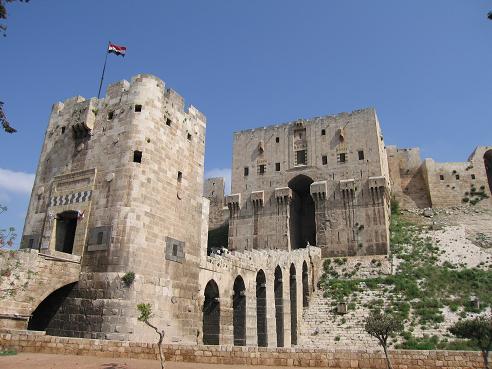
The Citadel afforded great views of Aleppo. We found the uniformity of color remarkable. With the exception of the mosques, most buildings were made from the same brown stone with no paint.

Some of the older buildings incorporated intricate stonework and the colors really stood out. This style of headscarf is a common accessory worn by men. Most of ‘khans’ (place for trade caravans to hole up) had huge doorways to accomodate heavily laden camels.

Our hotel in Aleppo had a bit of character, not the least of which was the bright Barbie pink decor of the rooms. It came comple with a TV and it became quite amusing to ‘run the gamut’ between the two broadcast channels (Syria I and Syria II). Syria II did have 15 minutes of news in English each evening.
The clock tower in Aleppo was right next to our hotel.
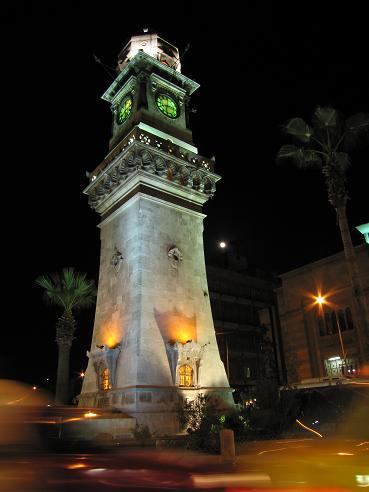
A sharply-angled building with celebratory bunting for the Prophet’s birthday.
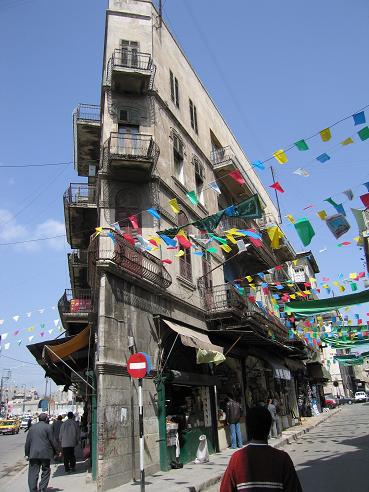
The so-called Christian quarter was a maze of narrow, steep alleyways filled with lingerie stores and the occasional church.

The National Museum at Aleppo had lots of ancient civilization artefacts, including this basalt relief of two man-bulls supporting the sun over a young Prince Gilgamesh.

Met a guy with a string tied around his wrist, and sure enough, he got it from a Buddhist monk in Thailand. Marcus, being proud of his eight-month-old string, asked how long he had it. FOUR YEARS!!! Now that’s good karma.
Here’s a bright and shiny ‘nargileh’ shop (water pipe).
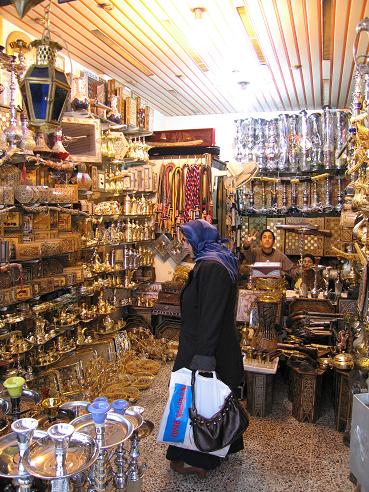
Some of Aleppo’s souqs (bazaars) are housed in very old buildings with cool ceilings.
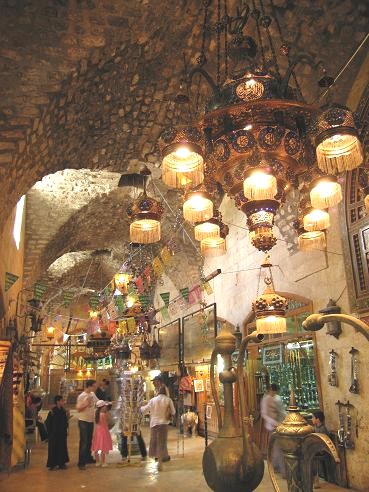
Lots of nicely scented shops selling soap, loofahs, spices and coffee. Marcus was in heaven (no, not because of the loofahs).
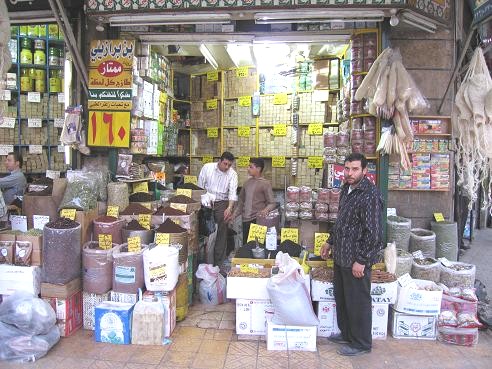
We took a remarkably cheap and comfortable bus to Hama. These buses were just as good as the ones in Turkey, but they didn’t distribute the lemon-scented hand cologne (a bonus in our opinion).
The norias of Hama are their claim to fame and the Four Norias are considered the best of the bunch. These things are huge! Aparently they have been around since at least the 4th century and are used for transfering water up to an aqueduct. The complex structures are made entirely of wood and the huge wood bearings let out a load groan as the wheels turn.
The Four Norias of Hama.
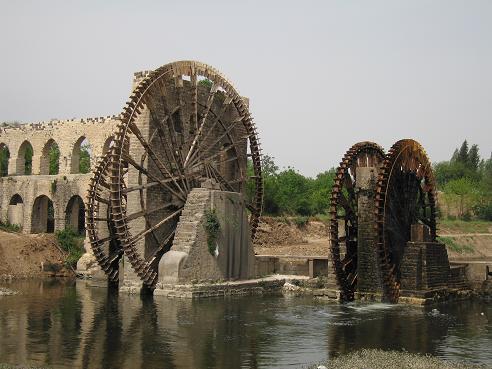
Here’s a different noria with Kelly for scale.
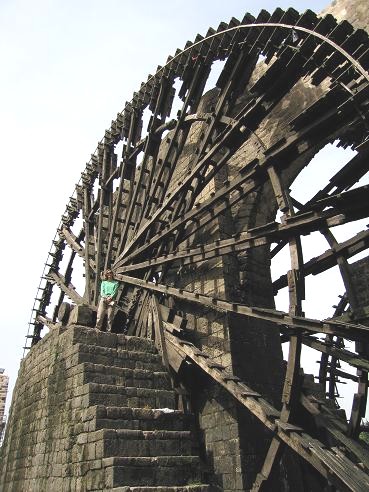
On the way to Apamea, we stopped at a museum that was swarming with a busload of incredibly friendly school kids. We tried out our Arabic on them the whole time and skipped the museum. They gave us a postcard from the mosaic museum to remember them by. It was sweet. Here’s a couple of them with their teacher.
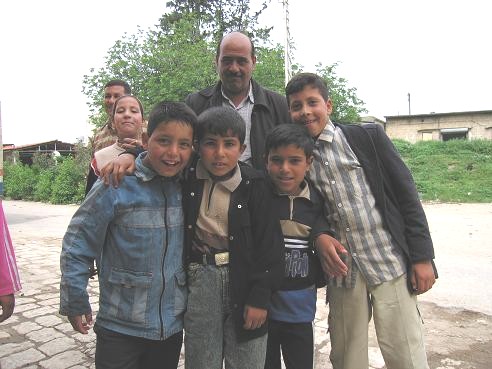
Apamea was a 2nd century BC city with a long, columned way. More impressive were the huge fields of red poppies and all the cool bugs (more on that in another entry).

No better place for a family picnic than a Dead City. No one knows why the Dead Cities were abandoned and they were in remarkably good shape. This family invited us to join them and their meter-long nargileh they brought for the occasion.

We spent Easter visiting the enormous Crusader castle of Crac des Chevaliers. The castle never fell, but Jerusalem had been lost and the Crusaders eventually left. Aparently they had enough supplies stored to hold out for five years without resupply.
The intimidating inner fortress at Crac des Chevaliers.
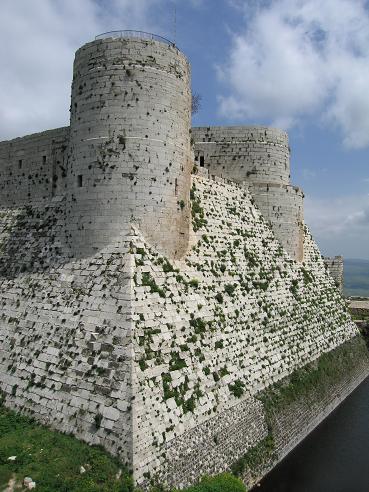
Crac des Chevaliers was quite large. There’s a whole tour group on the square tower for scale.
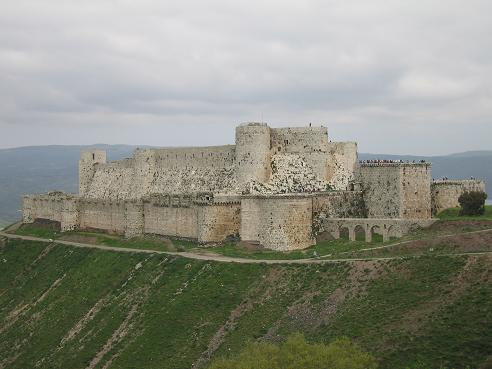
The food in Syria is FANTASTIC! Of course the felafel and hummus are to die for. We had eaten baba ghanoug before, but never really thought much of it. Here, baba ghanoug is more like eggplant salsa. But ‘muttabel’ is a creamy blended version that is more like hummus with a strong smokey flavor and is great! There are also tons of fresh fruit juice stands that will blend your fruits of choice for less than a buck. Asking for a ‘cocktail’ gets you a blend of something like orange, carrot, strawberry, and banana. We also discovered (Lebonese) ‘fatoush’ which is a tangy vinaigrette salad with lots of fried pita chips.
We’re loving it. Clockwise starting with the fries, hummus, fatoush, pita, hummus, muttabel (yeah, we really like hummus).
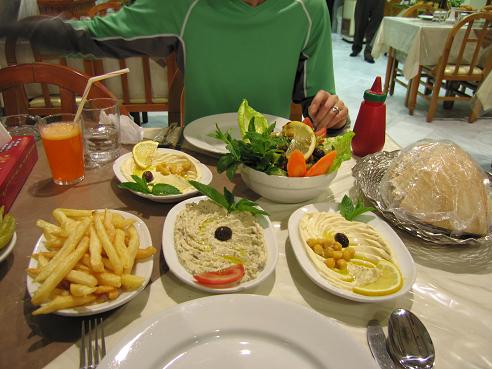
We had to take a local bus to Palmyra because it was a national holiday, but it actually ended up having so much character that it was still a great ride. The best part was the enormous bleeding eye with an arrow sticking out of it that was plastered over the windshield. Palmyra is near an oasis in the middle of nowhere (and 140 miles from Iraq). The site is huge and the ruins are made from a golden stone that has eroded in cool patterns.
We got up early and had the entire site to ourselves; well, we had to share it with a few camels. At least there’s one good thing about packaged tours and that is they all have to have their breakfast before a hard day of ruin hopping.
Kelly at the Triumphal Arch that served as the entryway to Palmyra’s ruins.

Crumbling Corinthian columns at the temple of Ba’al (God of gods).

No spitting! We were surprised by the noises that camels make when they aren’t happy. A lot like Chewbacca.

While walking around town, we kept hearing “It’s a small world” played in a tinny, electronic way. We eventually figured out that many vehicles (bikes, buses, trucks) have somehow wired their brakes or reverse lights so that the tune is played when the brake or reverse. Weird.
Some of the funnerary towers at Palmyra. The bodies were stacked on tall racks like a baker’s oven.
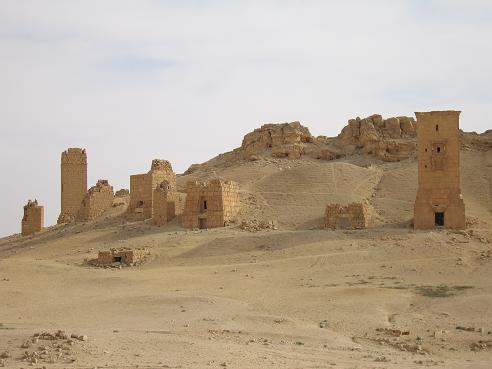
On our way into Damascus, a guy born in Turkey but lives in Syria helped us navigate the service taxis to get to Martyr’s Square, and even paid our fare. In fact, we’ve met quite a few solo female travelers in Syria who have been unable to pay their transport fares because the locals take such good care of them. Genuine hospitality; not seeking ‘favors’. Once at Martyr’s Square we again found ourselves disoriented and a local university student guided us to our hotel. We just can’t get over how friendly and helpful the Syrians are.
Note: those towers of baklava are as big as a person!
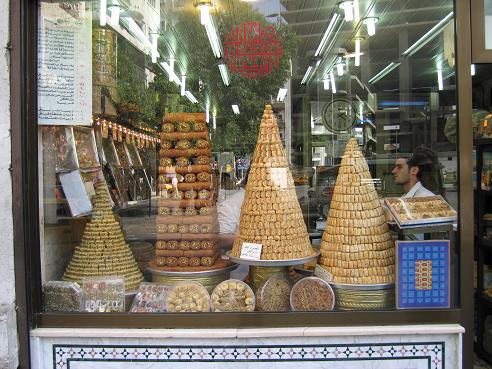
Knock, knock.
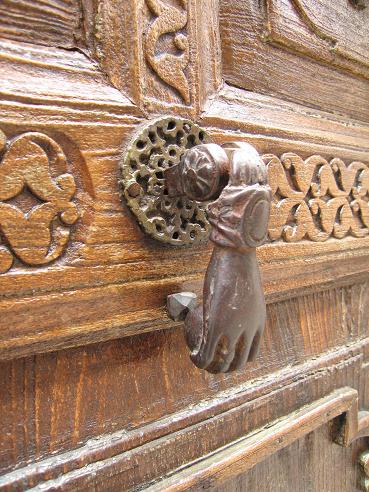
Speaking of bad jokes, we were in a crowded minibus and spied a young boy wearing a t-shirt in English that someone must have put him up to wearing. It read: “Treat me like the princess that I am.” Thankfully we didn’t have the Arabic skills to tell him what it meant.
Drink dude on a street in Damascus. The outfit and fancy drink dispenser weren’t for tourists. We started seeing this style of baggy trousers in Turkey, but the crotch had decended nearly to the ankles by Damascus.
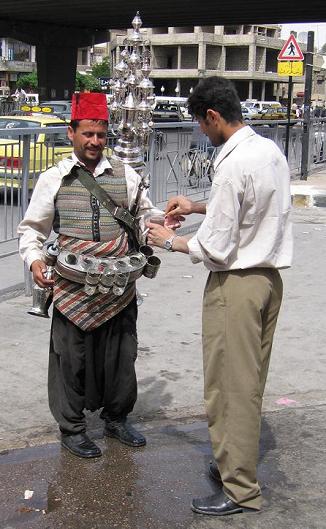
Kids at a ‘madrassa’ (religious school) in Damascus taking a break from studying the Qur’an.
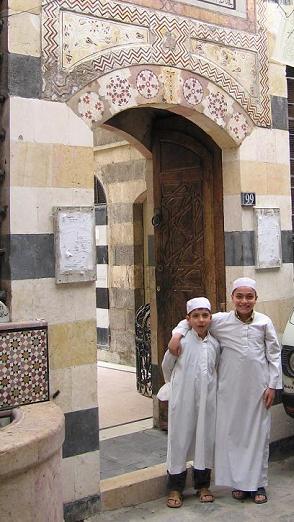
Damascus lays claim to being the oldest, continuously inhabited city in the world. It had another national museum that was even more impressive than the one in Aleppo. Unfortunately, no photos were allowed. That’s a bummer because they had a finger-sized clay tablet that contains the oldest known alphabet in the world (Ugarit, 1400BC). Talk about the craddle of civilization.
The Umayyad mosque in Damascus dates from 705AD and is one of the oldest in the world. It was huge and had a picnic atmosphere with loads of families camped out inside.
Door keeper at the Umayyad mosque in Damascus.

“Lightning bolt!” Kelly was looking quite fashionable in the Gandalf cloak required for all women entering the mosque. Behind her are the beautiful organic mosaics with tons of gold and green.
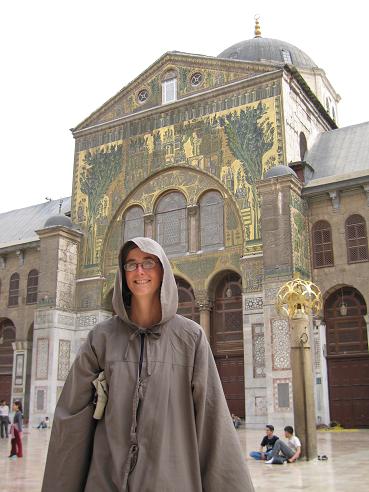
The stone ‘mihrab’ (niche indicating the direction of Mecca) was incredibly ornate.
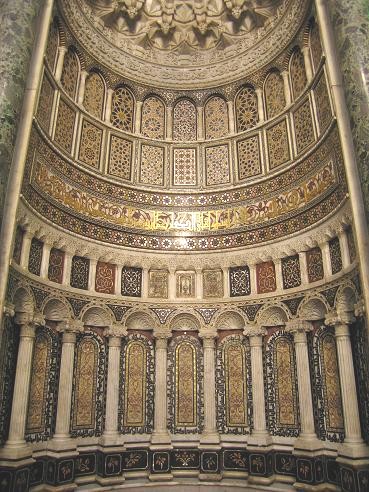
Lots of geometric patterns in the mosque.
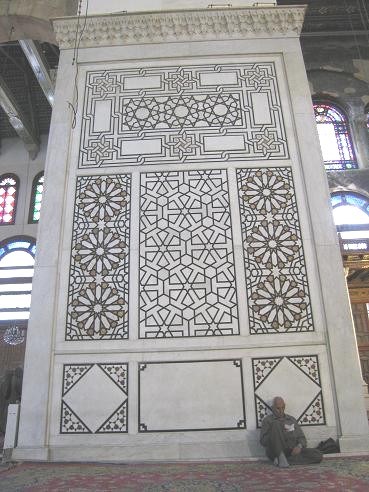
The Sayyid Ruqayya shrine is an Iranian Shiite tomb that is spectacularly tiled in blue and tiny mirrors. The visiting pilgrims were quite emotional about the tomb’s occupant (who died in 680AD) and were chanting, wailing, and beating their chests.

The bustling souq in Damascus. Don’t even bother coming on Friday when it’s completely dead. The place had fantastic ice cream vendors selling something that was a mix of vanilla and lemon and rolled in sliced pistachios.
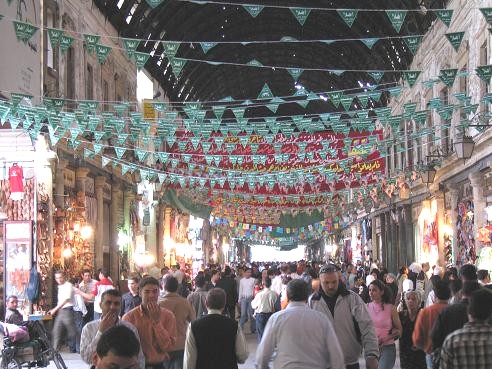
While wandering the Christian quarter of the old city in Damascus, we passed many shops selling the cool inlaid wood boxes that we had seen in Turkey. But these were noteworthy because they had plastered stickers of Jesus over them.
Lots of water pipe shops in these parts. Marcus’ attention is always drawn to shiny objects.
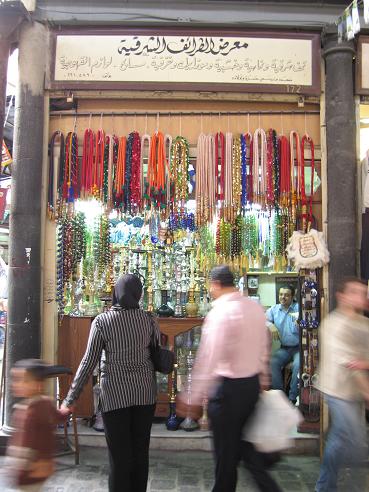
We loved the striped buildings with alternating white stone and black basalt. This is the Khan As’ad Pasha off the main souq in Damascus.
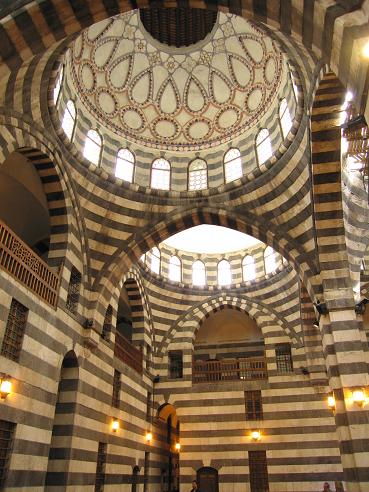
This alarmingly tilted building should have been red tagged.
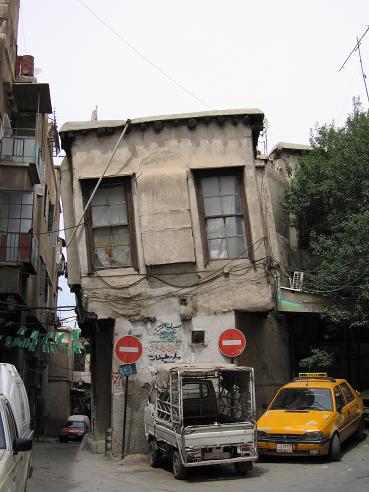
Marcus sensed the end was near for his beloved “good luck” string. This was taken the morning we left Syria.
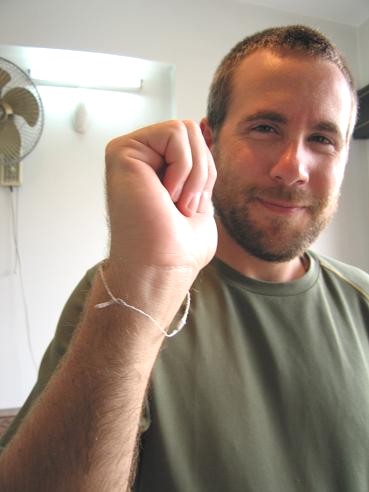
At the border crossing, we left Syria without incident. While emptying his pockets for the Jordanian security check, the string broke and fell unceremoniously to the ground. A fine example of the impermanence of all material things. He recovered it as a souvenir, but was thankful it had served us well for so long.
What a fantastic country! We can’t wait to go back.
Tags: Syria

May 3rd, 2006 at 8:07 pm
Now you have to go back to Thailand and get another string bracelet! Gotta keep that good luck for the rest of the trip!
BTW Gilgmesh never looked better – I’ll have to share that one with the SS classes; they know all about Gilgamesh 🙂
NO nephew yet….
May 8th, 2006 at 10:58 am
I’ve really enjoyed reading about your adventures in Syria. It’s not somewhere I’ve ever considered visiting, and maybe I should as it looks a pretty interesting country. I loved the photos too.
May 10th, 2006 at 10:49 pm
mmmmm muttabel… I’ll have to hit Zankou soon…
Palmyra’s triumphant arch looks like its about to lose its keystone. did it look that precarious in person? You know, I’ve heard that tilted buildings are a big draw in Italy. I guess after the Rome fell apart, so did the quality of their engineering.
May 12th, 2006 at 2:10 am
Yeah Pete. It was ready to crash. I remember trying Zankou’s felafel once and never went back. Will have to go out for muttabel with you some day.